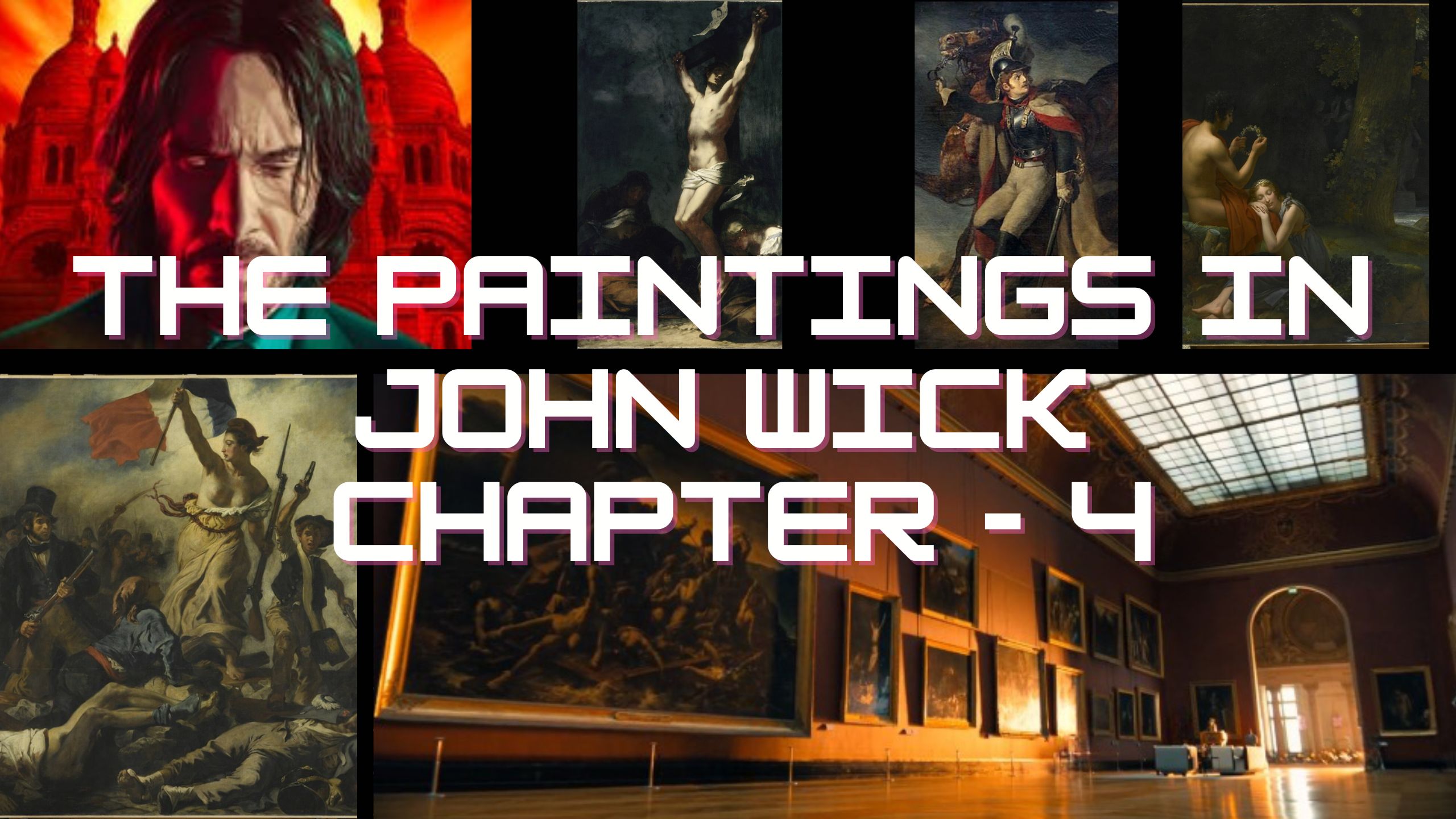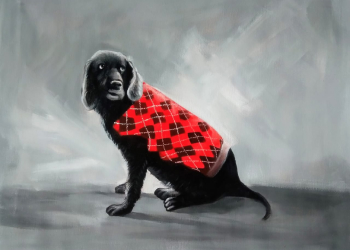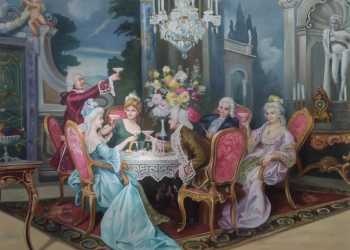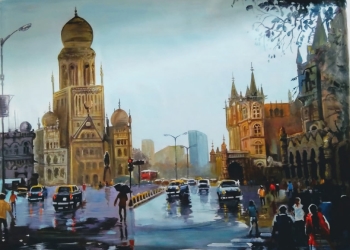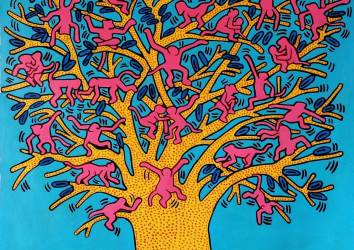The Paintings of John Wick Chapter 4: Decoding the Symbolism Behind the Paintings
What paintings were in John Wick Chapter 4? What is the meaning of the paintings in John Wick 4? Do they have any significance to the underlying plotline and the story? Was it shot in a real museum? To find the answers to these intriguing questions read on.
It's not often, scratch that, actually never have we written about a movie in this blog. We write about movies and films only when art plays a significant role in it. For example, we wrote about the new Coca-Cola ad and all the historical paintings and art featured in it. It was well received. Thank you for your love and support.
After watching John Wick 4, we felt we should write about it too. We wanted to write this for some time now. But it took some time to gather all the stuff together to answer questions like What paintings were in John Wick Chapter 4? What is the meaning of the paintings in John Wick 4? Do they have any significance to the underlying plotline and the story? Was it shot in a real museum? To find the answers to these intriguing questions read on.
Are the paintings in John Wick Chapter 4 real?
In the visually captivating world of John Wick: Chapter 4, art takes center stage, intertwining with the intense action and riveting storyline. As we delve into the stunning scenes where art becomes a character in itself, we wonder are the paintings in John Wick 4 real.
The paintings featured in the movie are indeed real. The art gallery scene of John Wick Chapter 4, also known as the Long Walk sequence was shot in Room No. 700, popularly known as the Red Room at Louvre Museum, Paris, France.
What is the meaning of the John Wick 4 paintings?
When researching this piece we wondered if there is a meaning behind the John Wick 4 paintings. To our surprise, most of the artworks had a meaningful meta-connection with the underlying plot of John Wick Chapter 4. Each painting has a different meaning and connections to the plotline and characters of John Wick Chapter 4. After reading this post, you are likely to appreciate the movie even more. And appreciate the efforts and eye for detail of the director Chad Stahelski And the efforts of the cast and crew led by Keanu Reeves, Laurence Fishburne, Ian McShane, and Bill Skarsgård to translate that vision of producer/director Chad Stahelski into cinematic reality.
Order Your Custom Handmade Oil Portrait Painting from Photo today
Plotline: John Wick Chapter 4
John Wick Chapter 4 is a sequel to the earlier movie, John Wick Chapter 3, Parabellum.
In the movie, John seeks revenge against the High Table while recuperating in the Bowery King’s shelter. He travels to Morocco and eliminates the Elder. In retaliation, the High Table appoints Marquis Vincent Bisset de Gramont a high-ranking French aristocrat tasking him with the job of eliminating John Wick. Granting him vast resources to do the job.
John Wick hides out in Japan in the Osaka continental run by his friend. But the assassins of the Marquis soon find him out. A deadly fight ensues in the Osaka Continental.
John Wick escapes from Japan and returns to New York where he regroups with Winston. Winston seeks his revenge against the Marquis for destroying his hotel New York Continental. He proposes to John to challenge the Marquis in a duel to death, invoking an old High Table tradition. But to issue such a challenge John must have the backing of one of the crime families. Winton advises John to seek readmittance to the Ruska Roma crime syndicate. Ruska Roma agrees to reinstate John Wick into the Ruska Roma family and back his challenge. On the condition, he must finish a job for the crime syndicate before his reinstatement. John completes his task and is reinstated into the syndicate. And John then challenges the Marquis to a duel.
Winston acts as a go-between the Marques and John while also acting as John's second. He communicates John’s challenge to a duel to the Marquis, in a meeting in Paris, who accepts. The Bowery King joins Winston in Paris at this juncture to help John prepare for the duel. The duel is set to take place at Sacré-Cœur Basilica, Paris with both sides agreeing to use dueling pistols. Many challenges confront John Wick on his way to the duel at the agreed place.
Now that you are up to speed, our interest and indeed the rest of the blog will be focused on a few sequences and a few seconds of shots in the entire movie.
Of particular interest are the artworks and paintings that can be seen in the backdrop. And rest of the post will be devoted to discussing these masterpieces of art and their meta-connection to the movie plot and the life of John Wick.
The first shot lasts 41 seconds and can be seen at 1:31:42 - 1:32:23 & the second shot last 167 seconds and can be seen at 1:47:40 - 1:50:27. The sequences can be named:
(i) John Wick Art Gallery Scene or The Long Walk (1:31:42 - 1:32:23)
(ii) Mairie des Lilas subway where the Bowery King and Winston help John prepare for the duel.(1:47:40 - 1:50:27)
John Wick Art Gallery Scene or The Long Walk
Most of the paintings in the movie are from the Neoclassical and Romantic periods, made between 1750-1850.
The shot happens when Winston meets the Marquies to deliver John's challenge to a duel. In the film shot, Winston walks through a large hall to meet the Marquis. Although the sequence lasts 41 seconds, we see 12 of the 14 masterpiece artworks in the scene.
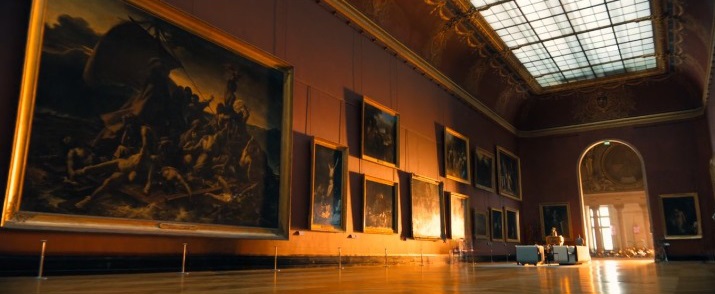 John Wick Art Gallery Scene (Image Credits: ScreenGrab)
John Wick Art Gallery Scene (Image Credits: ScreenGrab)
Was John Wick filmed in Louvre?
The Art Gallery/ the Long Walk scene was shot in Room No. 700 at the Louvre Museum. Also known as the Les Salles Rouges - the Red Rooms. The Red Rooms get their name from the red color of their walls. Some of the largest paintings of the Louvre are housed in them including the masterpieces of the great 19th-century painters like Delacroix and David.
What paintings were in John Wick Chapter 4
The art gallery scene within John Wick 4 is a visual feast for art enthusiasts and film aficionados alike. The juxtaposition of opulent paintings with the pulse-pounding action creates a mesmerizing contrast, drawing us into the character's world while immersing us in the allure of artistic expression.
The following paintings and artworks appear in the Long Walk sequence. In order of appearance
-
Napoléon on the Battlefield of Eylau, oil on canvas, by Antoine-Jean Gros, 1807-1808
-
The Wounded Cuirassier, oil on canvas by Théodore Géricault, 1814
-
The Raft of the Medusa, oil on canvas, by Théodore Géricault, 1818-1819
-
Le Christ sur la Croix, oil on canvas by Pierre-Paul Prud'hon, 1822
-
Paysage: Thésée poursuivant les Centaures, oil on canvas, by Achille Etna Michallon, 1821
-
The Barque of Dante, oil on canvas by Théodore Géricault, 1822
-
Liberty Leading the People, oil on canvas by Eugène Delacroix, 1830
-
La robe ensanglantée de Joseph apportée à Jacob, oil on canvas by François-Joseph Heim - 1817
-
Daphnis et Chloé, oil on canvas by François Baron Gérard, 1825
Paintings behind Bisset de Gramont (1:32:19 -1:32:23)
-
The Death of Sardanapalus, oil on canvas by Eugène Delacroix, 1827
-
A Young Tiger Playing with Its Mother, oil on canvas, by Eugène Delacroix, 1830-1831
-
David jouant de la harpe pour le roi Saül, oil on canvas by Antoine-Jean Gros, 1822
(ii) Mairie des Lilas subway (1:47:40 - 1:50:27)
-
The Incredulity of Saint Thomas, oil on canvas by Caravaggio, 1602
-
The Feast of Herod (The Killing of John the Baptist)
Handmade Art Reproductions & Landscape Paintings
The paintings and artworks in the Art Gallery Scene and their meaning
The following paintings appear in the Art Gallery scene or the Long Walk sequence when Winston meets up with the Marquis to deliver to him John Wick’s challenge to a duel. The paintings and their meaning and connection to John Wick are analyzed below.
Napoléon on the Battlefield of Eylau, oil on canvas, by Antoine-Jean Gros, 1807-1808
The first painting that comes into our view is Napoléon on the Battlefield of Eylau by Antoine-Jean Gros painted in 1807-1808.
The History painting depicts the scene following the intense Battle of Eylau, between the French and the Russians, (7–8 February 1807), portraying Napoléon Bonaparte as he surveys the battlefield. His Grande Armée achieved a hard-fought victory against the Russian forces, showcasing the high price he paid for securing triumph.
Napoléon wanted to commemorate the hard-fought victory and entrusted the director of the Louvre Vivant Denon to commission an artist. A competition was held for the commission. 26 artist sent their sketches for the painting and Antione-Jean Gross was selected as the winner.
Napoleon is depicted in the middle of the painting riding a horse and looking over the injured men. He stretched out his hand, and his pale face turned to heaven, symbolizing his inner pain. Napoleon here seems to giving his blessing. The personification of humanity and compassion, extending generosity to enemy soldiers. A vision designed “to instill in princes a love of peace and a horror of war” as the 64th Grande Armée Bulletin put it.
The massive oil painting on canvas has become one of the icons of French Romanticism.
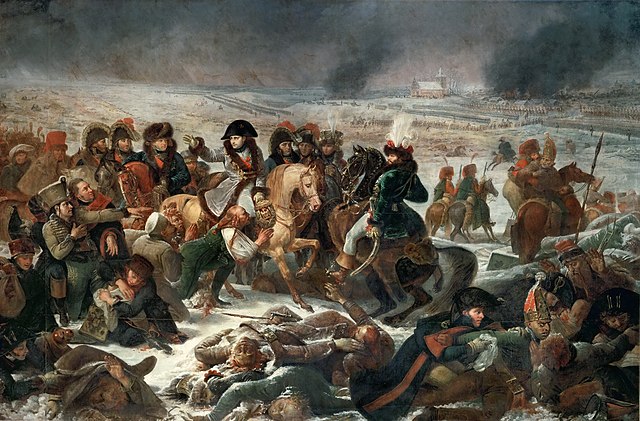 Napoléon on the Battlefield of Eylau, oil on canvas, by Antoine-Jean Gros, 1807-1808 (Image Credits: Wikipedia.org)
Napoléon on the Battlefield of Eylau, oil on canvas, by Antoine-Jean Gros, 1807-1808 (Image Credits: Wikipedia.org)
Title: Napoléon on the Battlefield of Eylau
Creator: Antoine-Jean Gros
Date Created: 1807-1808
Physical Dimensions: 205 inches × 309 inches (521 cm × 784 cm)
Medium: Oil painting on canvas
Location: Musée du Louvre, Paris, France
Meaning of the painting Napoléon on the Battlefield of Eylau in John Wick and its connection to his ethnicity
The Battle of Eylau between the French and the Russians provides an intriguing connection to the plotline of John Wick. In John Wick Chapter 4, we finally get the answer to the question, What ethnicity is John Wick?
John's ethnicity is Russian. John Wick was born Jardani Jovonovich a Belarussian. The term "Belarus" has a close connection to the term "Belaya Rus'," which translates to "White Rus'. Leading to the common reference of Belarus as "White Russia."
Within the narrative of John Wick Chapter 4, the painting takes on the role of an analogy, illustrating the recurrence of historical patterns. Here, the Marquise embodies the French, launching an assault on the Russians symbolized by Jardani Jovonovich. The lingering question revolves around which side will ultimately prevail. The French forces are symbolized by The Marquise or the Russian faction is symbolized by John Wick.
The Wounded Cuirassier, oil on canvas by Théodore Géricault, 1814
The Wounded Cuirassier is the second painting we see in the shot.
"The Wounded Cuirassier" (French: "Le Cuirassier blessé quittant le feu") is a painting by French Romantic artist Théodore Géricault (1791–1824). The oil painting on canvas depicts a solitary soldier and his nervous horse descending a slope.
Unveiled in the aftermath of France's disastrous military campaign in Russia, the life-sized painting effectively conveyed the sentiment of a nation grappling with defeat. Although no visible injuries on the soldier, the title has been interpreted at times as a reflection of the soldier's wounded pride. In contrast to Géricault's "Charging Chasseur," this painting starkly departed from themes of glory and the theatricality of warfare.
First presented at the 1814 Salon, the artist deliberately shifted his focus from heroic scenes to portray a subject aligned with the losing side of a battle.
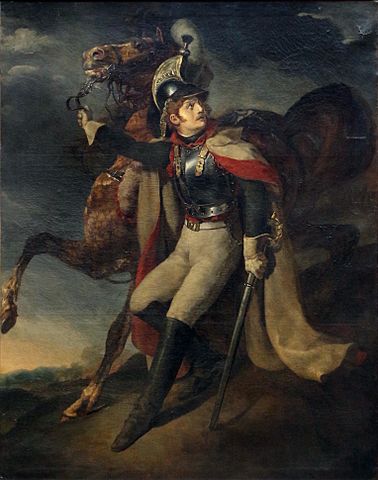 The Wounded Cuirassier, oil on canvas by Théodore Géricault, 1814 (Image Credits: Wikipedia.org)
The Wounded Cuirassier, oil on canvas by Théodore Géricault, 1814 (Image Credits: Wikipedia.org)
Title: The Wounded Cuirassier
Creator: Théodore Géricault
Date Created: 1814
Physical Dimensions: 141 inches × 116 inches (358 cm × 294 cm)
Medium: Oil painting on canvas
Location: Musée du Louvre, Paris, France
The Raft of the Medusa, oil painting on canvas, by Théodore Géricault
Next to The Wounded Cuirassier, we see The Raft of Medusa, the largest painting seen in John Wick Chapter 4.
Painted by Théodore Géricault (1791-1824) in 1818-19, this uncommissioned work of Géricault first made its public appearance in the 1819 Paris Salon and launched his career as an artist.
The Raft of the Medusa, aka Scène de Naufrage (Shipwreck Scene), was a radical work of art. The oil painting with a colossal canvas measuring just over sixteen by twenty-three feet, has become an icon of French Romanticism.
The painting depicts a raft, built of scrap lumber, rocking on the ocean waves. With interwoven figures ascending to the right of the canvas. At the top of the group, a black man waves a red and white cloth signaling to a far-off ship. Below him is the living who seek rescue from the dead and dying.
At the bottom left the dead and the dying are painted. A man with gray hair, a beard, and a crimson cloth over his head is sitting on the raft with his right hand supporting his head. His left hand is holding the body of his dead son. Whose lifeless, alabaster body is dangling from the edge of the raft. The lower part of the image is filled with bodies that are about to drown under the water.
The painting was based on a real-life incident that happened a few years before. In July 1816, the French naval ship Medusa set course for Senegal. Carrying the governor, his kin, and a coterie of officials, and passengers. Captained by Hugues Duroy de Chaumareys. The captain was appointed by Royal patronage rather than merit and had no real experience in sailing. The incompetency of the Captain led the ship to hit a sand bar off the coast of West Africa, near today's Mauritania. The ship's carpenter could not repair the ship. The Governor and the elites took lifeboats, leaving the rest 150 people on a makeshift raft measuring 65x23 feet cobbled from the ship's masts. The raft was then lashed on the lifeboats. But the raft hampered the progress of the lifeboats. So the elites in the lifeboats axed the lashes and set the raft adrift with 150 people on board. Of the 150 only 15 were rescued by the ship Argus that can be seen deep in the background. And Only 10 survived. Revealing the horrors of cannibalism, killings and forced drownings as the fight for survival became acute among those cast off in the raft. The incident became an international political scandal of the time. And left a deep impression on Géricault, who chose it as a subject for his painting to launch his career.
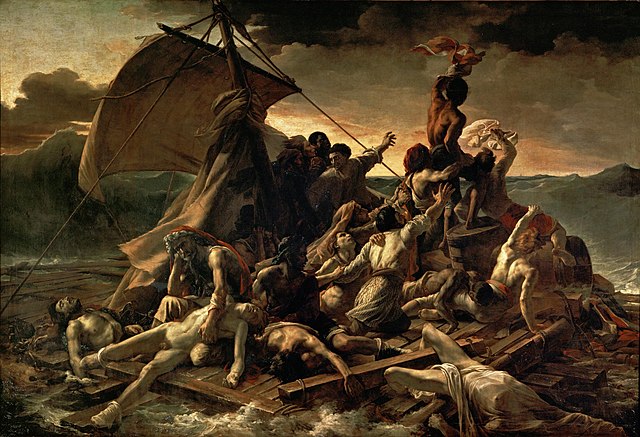 The Raft of the Medusa, oil on canvas, by Théodore Géricault, 1818-1819 (Image Credits: Wikipedia.org)
The Raft of the Medusa, oil on canvas, by Théodore Géricault, 1818-1819 (Image Credits: Wikipedia.org)
Title: The Raft of the Medusa
Creator: Théodore Géricault
Date Created: 1818-19
Physical Dimensions: 16 ft 1 inch × 23 ft 6 inches (490 cm × 716 cm)
Medium: Oil painting on canvas
Location: Musée du Louvre, Paris, France
Meaning of the painting The Raft of the Medusa in John Wick
In the movie, the painting becomes an allegory for the criminals of the underworld, where every man is for himself. Where survival instincts kick in and anarchy replaces order. As Winston reminds the Marquis — Because there are rules, and without them, We live with the animals. There are rules in the criminal world too. And without those rules, the criminal world is no different than the animal world. Driven by instinct. Without regard to the values.
The painting also serves as a comment on the Marquis, an analogy for the ship's captain, appointed by patronage rather than merit. And who through his arrogance and incompetence, run the ship of the criminal underground aground, hit by the sandbar of John Wick.
Le Christ sur la Croix, oil painting on canvas by Pierre-Paul Prud'hon, 1822
Pierre-Paul Prud'hon's (1758-1823) "The Crucifixion" exemplifies the Romanticism of the 19th century, emerging after neoclassicism. Completed in 1822, the painting portrays Christ on the cross, with Madeleine and the Virgin Mary at his feet. Prud'hon's mastery of chiaroscuro and realism is evident, illuminating Christ's body against a somber background.
The interplay of light and dark heightens the emotional intensity. Mary's palpable grief in the lower right corner resonates. Amidst this, Madeleine grieves in a shadowy corner. Further figures in the background also mourn.
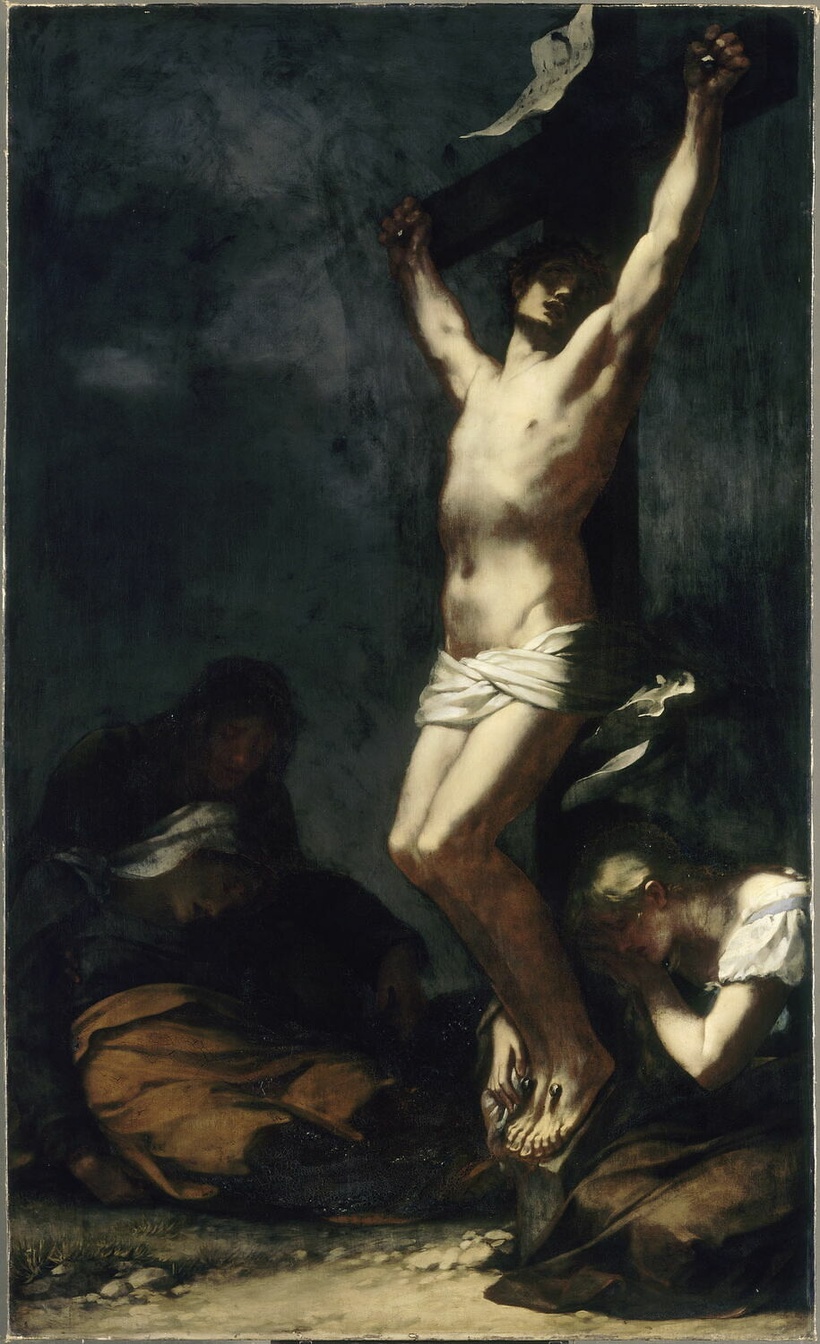
Title: The Crucifixion (Le Christ sur la Croix)
Creator: Pierre-Paul Prud'hon
Date Created: 1822
Physical Dimensions: 109.4 inches × 65.3 inches (278 cm × 166 cm)
Medium: Oil painting on canvas
Location: Musée du Louvre, Paris, France
Paysage: Theseus Pursuing The Centaur (Thésée poursuivant les Centaures) oil painting on canvas, by Achille Etna Michallon, 1821
As Winston walks past The Crucifixion, the painting Paysage: Theseus Pursuing The Centaur comes into view.
Painted in 1821, this was by French artist Achille Etna Michallon (1796-1822), a protege of the renowned Jacques-Louis David. Michallon's oeuvre frequently graced landscapes and historical narratives, demonstrating his adeptness at capturing the allure of nature and myth.
The artwork Paysage: Thésée poursuivant les Centaures unfolds a scene drawn from Greek mythology. The picture portrays the mythological figure of Thésée (Theseus) pursuing the Centaurs. Thésée was a legendary hero in Greek mythology known for his many adventures and heroic feats.
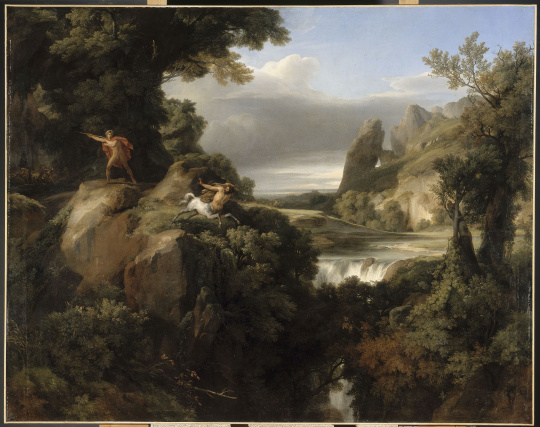 Paysage: Thésée poursuivant les Centaures, oil on canvas, by Achille Etna Michallon, 1821 (Image Credits: JocondeLab)
Paysage: Thésée poursuivant les Centaures, oil on canvas, by Achille Etna Michallon, 1821 (Image Credits: JocondeLab)
Title: Thésée poursuivant les Centaures
Creator: Achille Etna Michallon
Date Created: 1821
Physical Dimensions: 85.83 inches × 65.3 inches (218 cm × 107.48 cm)
Medium: Oil painting on canvas
Location: Musée du Louvre, Paris, France
Meaning of painting Thésée poursuivant les Centaures in John Wick
In Greek mythology, Theseus’ was great friends with Pirithous King of the Lapiths. Pirithous invited Theseus to his wedding; Among the many wedding guests, his neighbors the Centaurs (creatures with the body of a horse and the chest and head of a man) were also invited. The Centaurs were an unruly bunch who became drunk on too much wine and started creating trouble. When they tried to kidnap the bride, Hippodamia, Theseus quickly stepped in and defeated the Centaurs and saved his friend's bride.
Symbolically John Wick is Theseus of the painting who has come to vanquish the Centaurs (Marquis and his assassins) who are too drunk in their own power.
Order Your Portrait Painting from Photo today!
The Barque of Dante, oil painting on canvas by Eugène Delacroix, 1822
The Barque of Dante painted in 1822 is the first major work of French artist Eugène Delacroix (1791–1824). The painting draws from the events narrated in canto eight of Dante's Inferno, the first part of Italian writer Dante Alighieri's 14th-century epic poem Divine Comedy.
The painting depicts the unfolding of a treacherous journey undertaken by poet Dante, across the raging River Styx. In the backdrop, the darkened sky and smokey mist of the searing City of the Dead can be seen. Virgil, the sage of Classical antiquity, offers his steadying presence as Dante's barque (boat) plows through waves teeming with anguished souls.
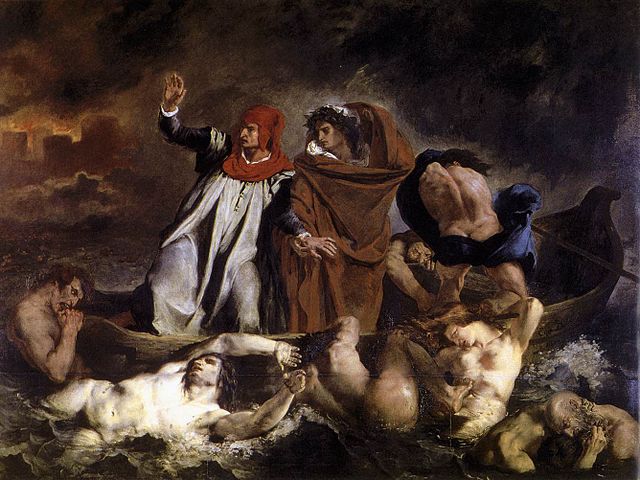 The Barque of Dante, oil on canvas by Théodore Géricault, 1822 (Image Credits: Wikipedia.org)
The Barque of Dante, oil on canvas by Théodore Géricault, 1822 (Image Credits: Wikipedia.org)
Title: The Barque of Dante
Creator: Eugène Delacroix
Date Created: 1822
Physical Dimensions: 74 inches × 95 inches (189 cm × 246 cm)
Medium: Oil painting on canvas
Location: Musée du Louvre, Paris, France
Meaning of the painting The Barque of Dante in John Wick
The painting Barque of Dante is an allegory for the impending journey through hell that awaits the protagonist John Wick as he challenges the Marquis to a duel.
Liberty Leading the People, oil painting on canvas by Eugène Delacroix, 1830
Among all the paintings that we see in the Long Walk sequence, Liberty Leading People is the most recognizable and famous.
Fun Fact: The painting "Liberty Leading the People" sparked Frédéric Auguste Bartholdi's creation of the Liberty Enlightening the World, also known as the Statue of Liberty in New York City, United States. This iconic statue was gifted to the United States by the French, half a century after the painting was made.
Liberty Leading People was painted by Eugène Delacroix (1798-1863) in 1830 to commemorate The French Revolution of 1830 aka Trois Glorieuses ("Three Glorious Days"), the July Revolution, or the Second French Revolution. That toppled King Charles X.
Delacroix made the painting in the Autumn of 1830. It was first exhibited in the official Salon of 1831. In a letter to his brother, Delacroix wrote, "My bad mood is vanishing thanks to hard work. I've embarked on a modern subject—a barricade. And if I haven't fought for my country at least I'll paint for her."
The composition depicts Liberty, as a classical Goddess and a woman. Wearing a Phrygian cap (symbol of freedom) on her head, holding high the French revolutionary flag, the tricolor, with her right hand and holding a bayonetted musket with her left hand. Her yellow dress fallen off her shoulder, as she looks back to energize her followers. She strides forward powerfully on the mound of wreckage bared footed and bare-breasted. The revolutionary fighters around her are drawn from all walks of life and social classes. The Bourgeoisie is represented by the young man in a top hat. A student wearing a traditional bicorn. The urban worker is symbolized by the young boy holding pistols. In the background, Notre Dame can be seen with the Frech flag fluttering on top.
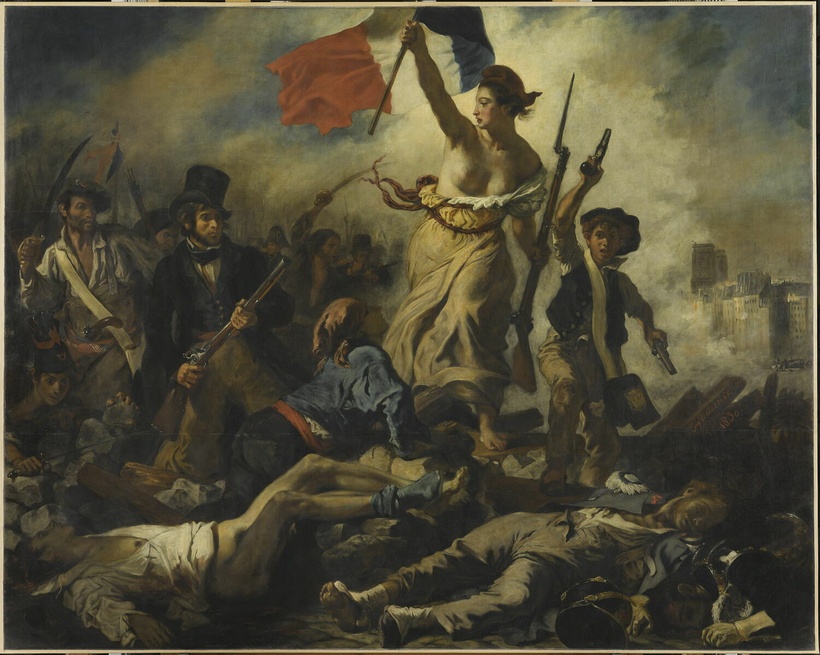
Title: Liberty Leading People
Creator: Eugène Delacroix
Date Created: 1830
Physical Dimensions: 102.4 inches × 128 inches (260 cm × 325 cm)
Medium: Oil painting on canvas
Location: Musée du Louvre, Paris, France
Meaning of the painting Liberty Leading People in John Wick
The painting is allegorical in the context of the movie and the plot line. At one level it reflects John’s struggle to be free from the High Table. He seeks freedom to live his life as a freeman. He seeks Victoriae fiducia, “The unconditional release of any and all obligations”
At another level, the painting foretells the fall of the Marque. Just as the July Revolution heralded the downfall of the French King Louis X, the challenge to a duel by John Wick will be the reason for the downfall of another King. King of the criminal underworld the Marquis.
La robe ensanglantée de Joseph apportée à Jacob, oil on canvas by François-Joseph Heim - Salon de 1817
In the Long Walk sequence, next to the painting of Liberty Leading People, on the right top is the La robe ensanglantée de Joseph apportée à Jacob, Joseph's bloody robe brought to Jacob, oil on canvas by François-Joseph Heim - Salon de 1817
Painted by the famed history painter, François Joseph Heim (1787-1865), the painting depicts a specific moment from the biblical story of Joseph and his brothers.
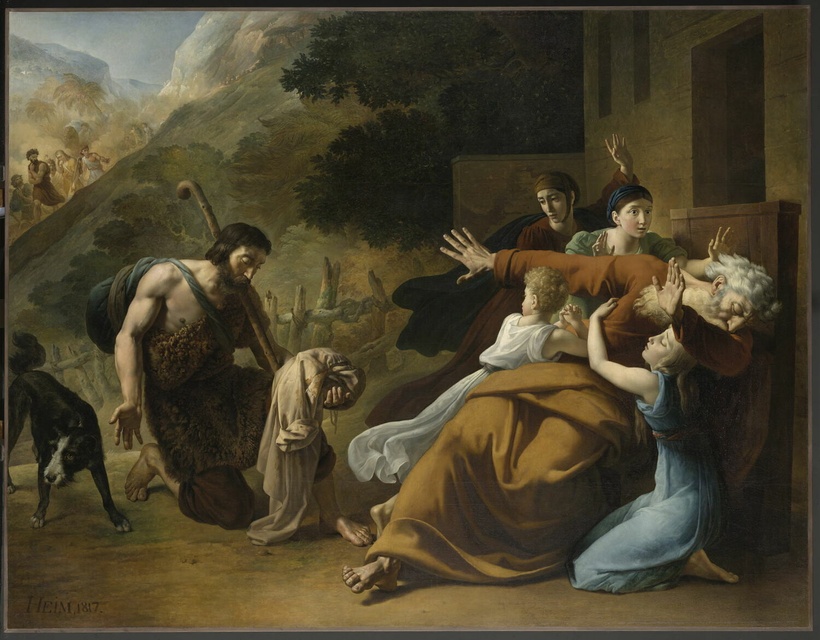
Title: Joseph's bloody robe brought to Jacob (La robe ensanglantée de Joseph apportée à Jacob)
Creator: François-Joseph Heim
Date Created: 1817
Physical Dimensions: 94.09 inches × 107.48 inches (238.98 cm × 272.99 cm)
Medium: Oil painting on canvas
Location: Musée du Louvre, Paris, France
In the biblical narrative, Joseph was the favorite son of Jacob, who gave him a special robe as a sign of his favoritism. This robe, often referred to as the "coat of many colors," was a symbol of Jacob's love and affection for Joseph. However, Joseph's brothers became jealous of him because of the special treatment he received from their father. In their envy, Joseph's brothers plotted against him and eventually sold him into slavery.
To deceive their father, the brothers took Joseph's robe, dipped it in animal blood, and presented it to Jacob as evidence that Joseph had been killed by a wild animal. Jacob, devastated by the news, mourned for Joseph, believing him to be dead.
Daphnis et Chloé, oil painting on canvas by François Baron Gérard, 1825
We see the painting of Daphnis and Chloe in the Long Walk sequence next to the painting Liberty Leading People, and below the painting Joseph's bloody robe brought to Jacob (La robe ensanglantée de Joseph apportée à Jacob)
The painting Daphnis and Chloe was painted by famous French portrait painter and artist François Baron Gérard (1770-1837), in 1825.
The couple painting portrays a scene from Greek mythology, capturing the tender love of Daphnis and Chloe. Amidst nature's embrace, youthful love shines. Daphnis garlanded with flowers, and Chloe, clinging to his arm, rest peacefully. Every brushstroke by artist Gerard illustrates intricate detail, evoking an ethereal calm. Soft light enhances the dreamlike aura. The painting radiates romance and serenity. A soothing timelessness amidst the turmoil.
Drawn from the tale of Daphnis and Chloe by Longus' 2nd-century A.D. the painting emerges from a pastoral narrative on Lesbos. Discovered as infants by different caretakers, Daphnis (a boy) and Chloe (a girl) grow up together and unknowingly fall in love. Their naive journey takes them through many dreams, challenges, separations, and eventual reunion. Embodying love's enduring embrace amidst the chaos.
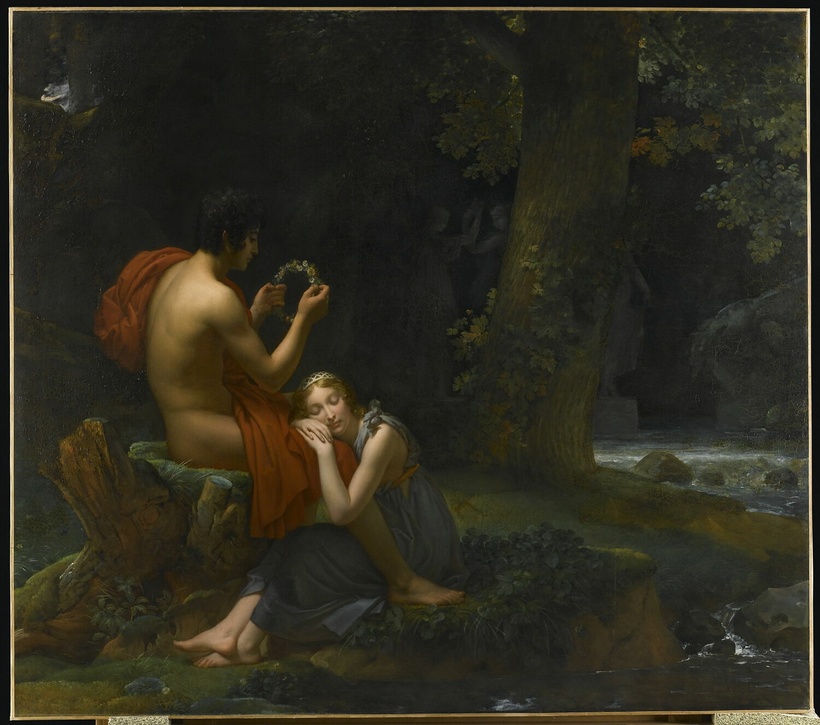
Title: Daphnis et Chloé
Creator: François Baron Gérard
Date Created: 1825
Physical Dimensions: 80.31 inches × 106.88 inches (203.98 cm × 271.47 cm)
Medium: Oil painting on canvas
Location: Musée du Louvre, Paris, France
Meaning of the painting Daphnis et Chloé in John Wick
The painting has an obvious connection to the life of John Wick. In the movie, we have seen references to John’s life before he was sucked back into the underworld to do High Table’s bidding.
John Wick had retired from the life of a hitman in order to marry his wife Helen. To earn his retirement he was given an “impossible task” to wipe out all the crime families in New York so only one crime family ruled over the city. He completed the task and was allowed to retire. John left behind his days as a Hitman and retired to a life of a peaceful happy man, in love with his wife Helen, who also loved him back. Until his wife succumbed to cancer.
The painting alludes to this peaceful love filled period of his life.
Paintings behind Bisset de Gramont aka Marquis de Gramont (1:32:19 -1:32:23)
At the end of the Art Gallery shot/Long Walk sequence, Winston finally reaches where the Marquis is seated on a white sofa and delivers John Wick’s challenge to a duel.
Behind the Marquis, we see a few more masterpieces.
The Death of Sardanapalus, oil painting on canvas by Eugène Delacroix, 1827
While watching the movie, if you wondered what’s the big painting behind Marquis in John Wick Chapter 4 here is your answer. The Death of Sardanapulis by Eugène Delacroix (1798-1863) is the most prominent and largest painting behind the Marquis painted in 1827.
The painting draws from the events of the tale of Sardanapalus, a king from ancient Assyria. Eugène Delacroix was inspired from Lord Byron's 1821 tragedy Sardanapalus. And Byron's story was influenced by the Greek historian Diodorus (first century CE).
The story goes that Sardanapalus was the last king of Nineveh, a city in the Mediterranean Sea in present-day Iraq. The king learns of an imminent attack on his city. Overwhelmed by the certainty of defeat and humiliation at the hand of his enemies, the King decides to destroy all of his precious possessions of concubines and horses. Rather than face and fight the enemy.
The composition depicts a large bed draped in rich red fabric. The king looks on with an indifferent expression while his servants carry out his orders and kill his most precious possessions of women and horses. His eyes remain impassive amidst the corpses strewn across his lavish room.
The painting employs dark shades and broad, expressive brushstrokes. Delacroix's use of painterly strokes infuses a strong sense of movement and dynamic motion in the work. The deep-red bed stands out against the dark backdrop. And violently contrasts with the creamy figures of the dying women and the shimmering gold objects strewn across the bed.
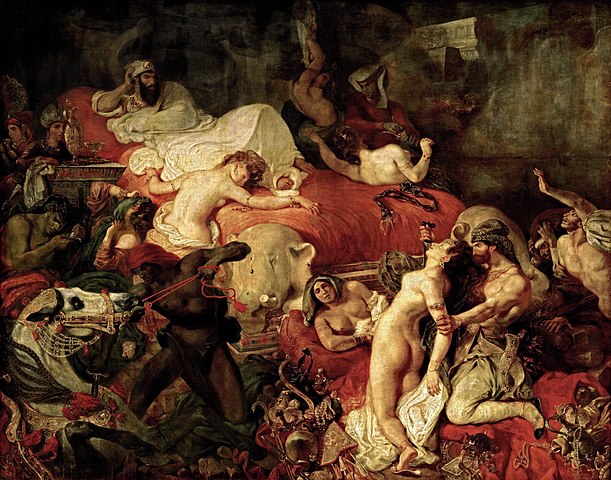 The Death of Sardanapalus, oil on canvas by Eugène Delacroix, 1827 (Image Credits: Wikipedia.org)
The Death of Sardanapalus, oil on canvas by Eugène Delacroix, 1827 (Image Credits: Wikipedia.org)
Title: The Death of Sardanapulis
Creator: Eugène Delacroix
Date Created: 1827
Physical Dimensions: 154 inches × 195 inches (392 cm × 496 cm)
Medium: Oil painting on canvas
Location: Musée du Louvre, Paris, France
Meaning of the big painting behind the Marquis, The Death of Sardanapulis in John Wick
Despite the outward appearance of arrogance and confidence, the painting allegorically portrays the desperateness of the Marquis. The painting symbolically informs the viewer of what is to follow, once the Marquis accepts the challenge. His destruction. The Marquise knows he is fighting an unwinnable war against an indefatigable and unflappable enemy John Wick. Unwilling to accept defeat and certain death at the hands of Babayega, he devotes all of his resources to destroying John Wick. The painting coveys this underlying theme.
A Young Tiger Playing with Its Mother, oil painting on canvas, by Eugène Delacroix, 1830-1831
The painting A Young Tiger Playing with its Mother can be seen on the left side of the Death of Sardanapalus, behind the Marquis.
The painting A Young Tiger Playing with Its Mother is an oil on canvas painting, painted by Eugène Delacroix (1798-1863) early in his career in 1830-31.
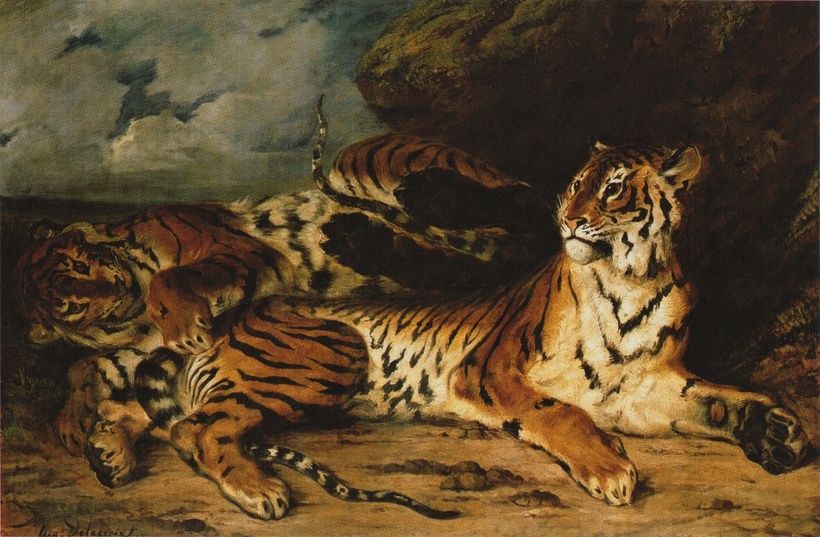 A Young Tiger Playing with Its Mother, oil on canvas, by Eugène Delacroix, 1830-1831 (Image Credits: Ministry of Culture, Govt of France)
A Young Tiger Playing with Its Mother, oil on canvas, by Eugène Delacroix, 1830-1831 (Image Credits: Ministry of Culture, Govt of France)
Title: A Young Tiger Playing with Its Mother
Creator: Eugène Delacroix
Date Created: 1830-31
Physical Dimensions: 52 inches × 76.6 inches (131 cm × 194.5 cm)
Medium: Oil painting on canvas
Location: The Metropolitan Museum of Art, New York, United States
The painting depicts a young tiger cub playing with its mother. According to art historians, fierce animals personify the emotions and passions of humans.
Meaning of the painting A Young Tiger Playing with Its Mother in John Wick
The painting is an analogy for the fierce emotions and passions of humans. As the artist Eugène Delacroix wrote in his journal at the time, “Men are tigers and wolves driven to destroy one another". A subtext on the state of relations between John Wick and the Marquis. And a subtle comment on the strife-ridden world.
David jouant de la harpe pour le roi Saül, oil on canvas by Antoine-Jean Gros, 1822
The painting David playing harp for King Saul, (David jouant de la harpe pour le roi Saül) can be seen on the right side of the Death of Sardanapalus, behind the Marquis.
Commissioned by Louis-Philippe d'Orléans, painted by Baron Antoine-Jean Gros (1771-1835), and exhibited in Paris Salon in 1822.
The painting portrays the biblical narrative of David soothing the envious King Saul. King Saul's jealousy over David's victory against Goliath led him to wish for David's demise. Yet, David's skillful harp-playing calmed the king's turmoil.
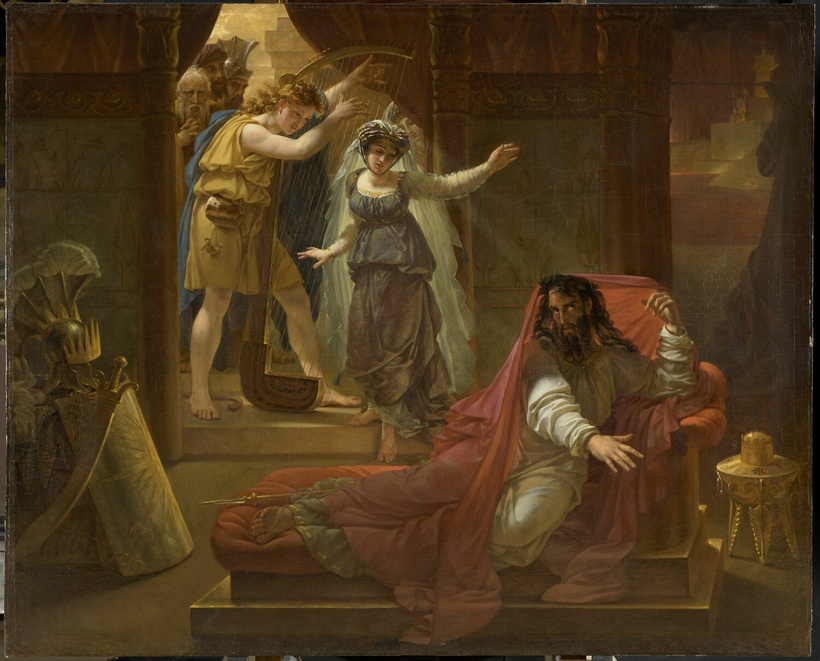
Title: David playing harp for King Saul
Creator: Baron Antoine-Jean Gros
Date Created: 1822
Physical Dimensions: 72.44 inches × 89.37 inches (184 cm x 227 cm)
Medium: Oil painting on canvas
Location: Musée du Louvre, Paris, France
The composition carries a subdued ambiance, heightened by the prominent use of deep red shades, symbolizing King Saul's mood. A serene and haloed blond David dominates the left side, plucking the harp. His tranquility contrasts starkly with Saul, consumed by internal struggles. Attendees observe the scene. The artwork delves into the dichotomy between Saul's inner turmoil and David's ability to ease with his musical prowess.
Meaning of the painting David playing harp for King Saul in John Wick
The painting's subtle connection between the disturbed mood of King Saul with the internal agitation of the Marquis juxtaposed with the clinical and erie calmness of John Wick. Except, in this case, there's no David to calm down the inner turmoil of a disturbed Marquis.
Mairie des Lilas subway (1:47:40 - 1:50:27)
The following artworks are seen in the Mairie des Lilas subway where the Bowery King and Winston help John to prepare for the duel.
The Incredulity of Saint Thomas, oil on canvas by Caravaggio, 1602
The Incredulity of Saint Thomas stands among Caravaggio's (1571-1610) renowned works. Created in 1602, it captures a pivotal event from the Gospel of St. John, when Jesus appears to St. Thomas, urging him to touch his wounds and dispel his doubts. Fun fact, this is the origin of the English term "Doubting Thomas"
The tale unfolds as St. Thomas, having missed Jesus' resurrection appearance, voices skepticism," Unless I see the nail marks in his hands and put my finger where the nails were, and put my hand into his side, I will not believe it". A week later, Jesus appears before him and two other Aposoltes to rest their doubts.
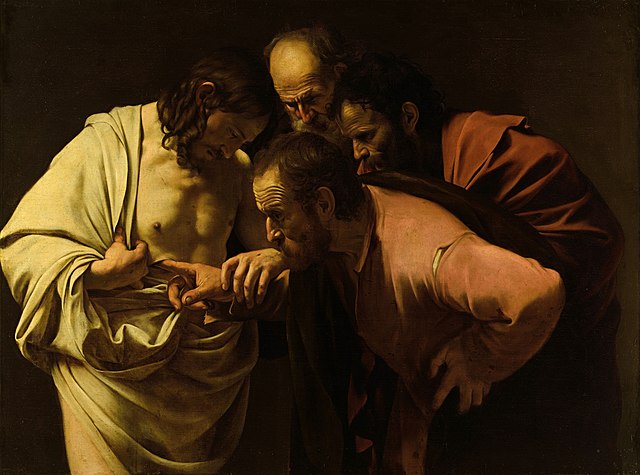 The Incredulity of Saint Thomas, oil on canvas by Caravaggio, 1602 (Image Credits: Wikipedia.org)
The Incredulity of Saint Thomas, oil on canvas by Caravaggio, 1602 (Image Credits: Wikipedia.org)
Title: The Incredulity of Saint Thomas (secular version)
Creator: Caravaggio
Date Created: 1602
Physical Dimensions: 42 inches × 57 inches (107 cm × 146 cm)
Medium: Oil painting on canvas
Location: Sanssouci, Potsdam, Germany
The composition centers on St.Thomas' hand, guided by Christ's, probing the wound. Thomas' face registers astonishment as Jesus leads his hand. Christ says, "Because you have seen me, you have believed; blessed are those who have not seen and yet have believed."
The painting employs chiaroscuro to symbolize doubt with shadow enveloping St. Thomas. An illuminated light on Christ accentuates his corporeal presence, suggesting divinity. The chiaroscuro technique forms a narrative flow: shadows shroud Thomas, but upon touching Christ, he enters the light. Caravaggio's mastery highlights his imaginative, emotive approach to this subject.
Meaning of the painting The Incredulity of Saint Thomas in John Wick
At the end of the previous movie John Wick Chapter 3, Parabellum, John is shot on the terrace and his body falls from the New York Continental. He is given up for dead by the emissary of the Hgh Table, The Adjudicator. The painting is a subtle nod to John’s resurrection.
The Feast of Herod ( (The Killing of John the Baptist), oil on canvas by Ambrosius Francken I
The Feast of Herod is the last artwork we see in John Wick Chapter 4. The painting Fest of Herod makes an appearance in the background, as John is getting ready for his final showdown with the Marquis in the underground subway of Mairie des Lilas.
The painting is attributed to Flemish painter, Ambrosius Francken I (1544–1618), well known for his religious and historical paintings. And a key figure in the artistic legacy of the Francken family.
The painting tells the story of another John, John the Baptist.
According to the Synoptic Gospels, Herod, a King in Galilee under the Roman Empire, imprisoned John the Baptist for rebuking him over an immoral marriage with his sister-in-law Herodias. On Herod's birthday, his niece, and daughter of Herodias, Salome, danced before the High Table of the King and his guests, pleasing him. A drunk Herod promised her anything up to half of his Kingdom. When Salome asked her mother (Herodias) what she should ask, she was told to ask for the head of John the Baptist on a platter. Although Herod was appalled by the request, he reluctantly agreed and had John executed by beheading him in prison. The episode is known as The Feast of Herod.
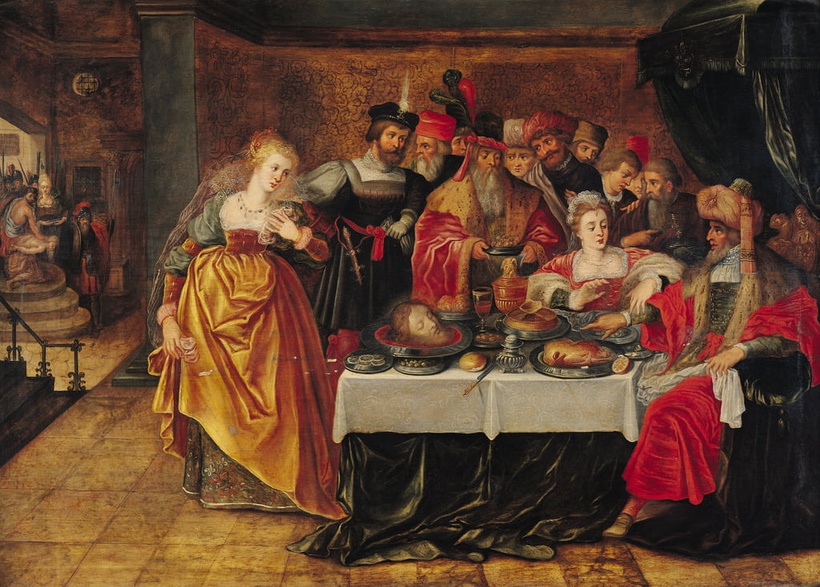 The Feast of Herod (The Killing of John the Baptist) (Image Credits: Southeby's)
The Feast of Herod (The Killing of John the Baptist) (Image Credits: Southeby's)
Title: The Feast of Herod
Creator: Manner of Ambrosius Francken
Physical Dimensions: 28.5 inches × 41.75 inches (72.4 cm × 106 cm)
Medium: Oil painting on panel
Meaning of the painting The Feast of Herod in John Wick
The painting makes a subtle reference to the original request of a "High Table" to execute John, who is troublesome to them and a threat to their authority.
A request made at a High Table of Herod's feast echoes in the present-day narrative that unfolds within the high-stakes world of assassins and rulers. A John was executed then, for causing trouble and challenging the authority of the High Table of the King. Centuries later, another request came from a different High Table to execute another John for causing trouble and challenging their authority.
Conclusion
While the film's artwork collection covers a range of styles and genres, the paintings featured in John Wick 4 have become a talking point among fans. From elaborate compositions to intricate details, these visual treasures contribute to the film's atmosphere, leaving us marveling at the intricate storytelling woven into each canvas.
About Us:
Paintphotographs.com is India's leading custom art platform. We turn your favorite photos, pics, and images into luxurious handmade portrait paintings. Our work includes handmade portraits, custom oil reproductions, charcoal drawings, and sketches. As a team of accomplished artists, we use museum-quality canvas, the best international brands of colors such as Winsor & Newton and Daler Rawney. We work with various mediums, including oil, acrylic, mixed media, graphite, and charcoal.
To order a custom handmade oil portrait painting you can visit our order now page. You can order custom Wedding Paintings, Couple Paintings, Memorial Paintings, Family Paintings, Baby portraits and Children Paintings, Photo to paintings, and Pet Portrait Paintings from Photo.
You can visit our pricing page to know the prices of our portrait paintings. To connect with us ping us on our chat messenger on the website, ping us on WhatsApp, call us at 918291070650, or drop us an email at support@paintphotographs.com
You can visit our gallery pages to see our work. We make photo to paintings, couple paintings, memorial paintings, Kids and Baby Portrait paintings, God & Religious Paintings, Old Photo to Paintings, Wedding couple Paintings & Marriage Portraits, Family Paintings, Pet Portrait Paintings, Radha Krishna Paintings, Oil Portraits of Gurus, Saints & Holy Men, Charcoal and Pencil Sketches, Custom Landscape & Cityscape paintings, Contemporary Art Reproduction & Replica Paintings, Old Master Reproduction & Replica Art, Monochrome and Black & White portrait paintings, Historical Portraits and Shivaji Maharaj Paintings, Celebrity & Political Leaders Portraits. We can also merge separate photos to create a single seamless painting called Composite portraits to add deceased loved ones to make a family oil portrait as though they were present.
Our custom handmade portraits make beautiful Anniversary Gifts, Engagement Gifts, Birthday Gifts, Retirement Gifts, Housewarming Gifts, Mother's Day gifts, and luxurious gifts for many important occasions.
Paintphotographs.com provides bespoke services for art patrons, interior designers, and architects. It helps you create the perfect pieces for residential and commercial projects and serves as a platform for artists to showcase their work.
If you are an art aficionado interested in writing a guest post on art, connect with us.
Want to read more? Check our reading recommendations below! Please refer to the Notes and Reference section for sources referenced in the article.
Like this story? Then you will love our podcasts on Spotify. Listen to our deep dives and fascinating stories from the art world. Join our nearly 20,000-strong community on Facebook, WhatsApp, and X.
Want to see our art? Join our community of 500,000+ subscribers on the Paintphotographs YouTube channel, Instagram, and Pinterest for some amazing art pics & art videos!
Recommended Pieces
How to Convert Your Photo into a Canvas Portrait Painting Online - Handmade
Photorealism: The Art of making a painting from a photo. | Paintphotographs
The life and paintings of artist and painter KCS Paniker | Paintphotographs
Why is Monalisa so famous? Monalisa's portrait painting history | Paintphotographs
Memorial Paintings - The Ultimate Guide to Commissioning one | Paintphotographs
Notes and reference section
Think big!Les Salles Rouges (The Red Rooms)
The Louvre Made Sure John Wick Wouldn't Shoot Any Art Before Signing On For Chapter 4
Napoleon visiting the battlefield at Eylau, 9 February, 1807

